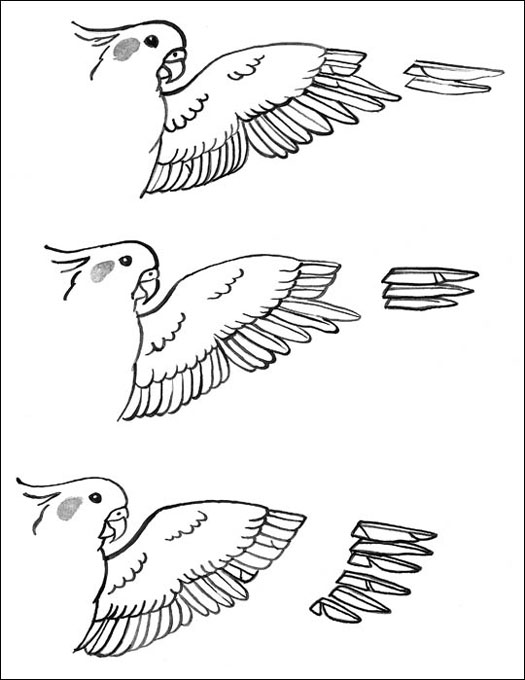
You can give your cockatiel varying amounts of flight capability depending on the amount of feathers you clip on her wings. With cockatiel chicks who haven't mastered flying, it's a good idea to gradually clip their wings. Cockatiels who learn to fly, land, and use their bodies to move about a cage are surer of themselves when they've lost the ability to fly. For this reason, start by clipping just the two outer flight feathers on each wing of a cockatiel who is just learning to fly. The cockatiel will be slowed down but will still fly quite well. About a week later, clip the next two feathers. The next week, clip the next two feathers, and so on. With this schedule, by the time a cockatiel is grounded, she will have gradually lost the ability to fly and gotten progressively better at controlling her mobility. She'll still confidently hop about a cage and will know how to land. Ideally a breeder will use this method of clipping before you ever get your bird. You can give your own bird the chance to learn about flying at any age, though, by letting her wings grow back and gradually clipping them back in this way.
Cockatiels who are clipped as very young chicks, before they attain motor skills and know how to handle their bodies to fly and land, often "crash land" and break their tail feathers or hurt themselves.
When trimming a cockatiel's wing feathers, be sure to do a symmetrical job, trimming both wings an equal amount. Your cockatiel not only will look good but, more importantly, will be balanced when she flies or sails along. You don't want to make her clumsy.
How often to clip
When deciding how much to clip your cockatiel's wings, consider her environment. If she lives in an aviary with a safety area, then flight is permissible for her, and she'll get lots of exercise. If you plan to enter your cockatiel in exhibitions, the judges will consider her total confirmation, so you'll want to show her with unclipped wings. If your cockatiel lives in the company of cats and dogs and you want to be sure that she can escape from them, you may want to leave her some flight capability. If you want to allow your cockatiel to fly in the house, but slow enough that she's not likely to hurt herself, leave more of her wings unclipped. If your cockatiel may be able to get outside, or could go through a window or door in your home because they're often open, you probably want to give her the most severe clip. If you have a bossy, dominant male cockatiel, a fairly severe wing clip will change his attitude. If you're just getting to know a new, older cockatiel, clip rather severely also. A severe wing clip will help you to work with an older cockatiel, as she'll be more dependent on you to help her get around. If you need to chase after her, you won't have to go as far, either! She also won't hurt herself in any mad flights about unfamiliar territory.
What to clip
Don't clip more than 10 primary feathers from a cockatiel's wings (see Figure 1). If you want to give your cockatiel some ability to fly, clip fewer feathers or clip the feathers farther down, merely shortening them. Your cockatiel will still need to have wing exercise, especially with clipped feathers. Take some time every day to hold her feet and encourage her to flap. Chances are good she'll develop some strong chest muscles by using what wing feathers she has to get around. It really isn't possible to ground a cockatiel. You'll be surprised how well your clipped cockatiel can get around.

